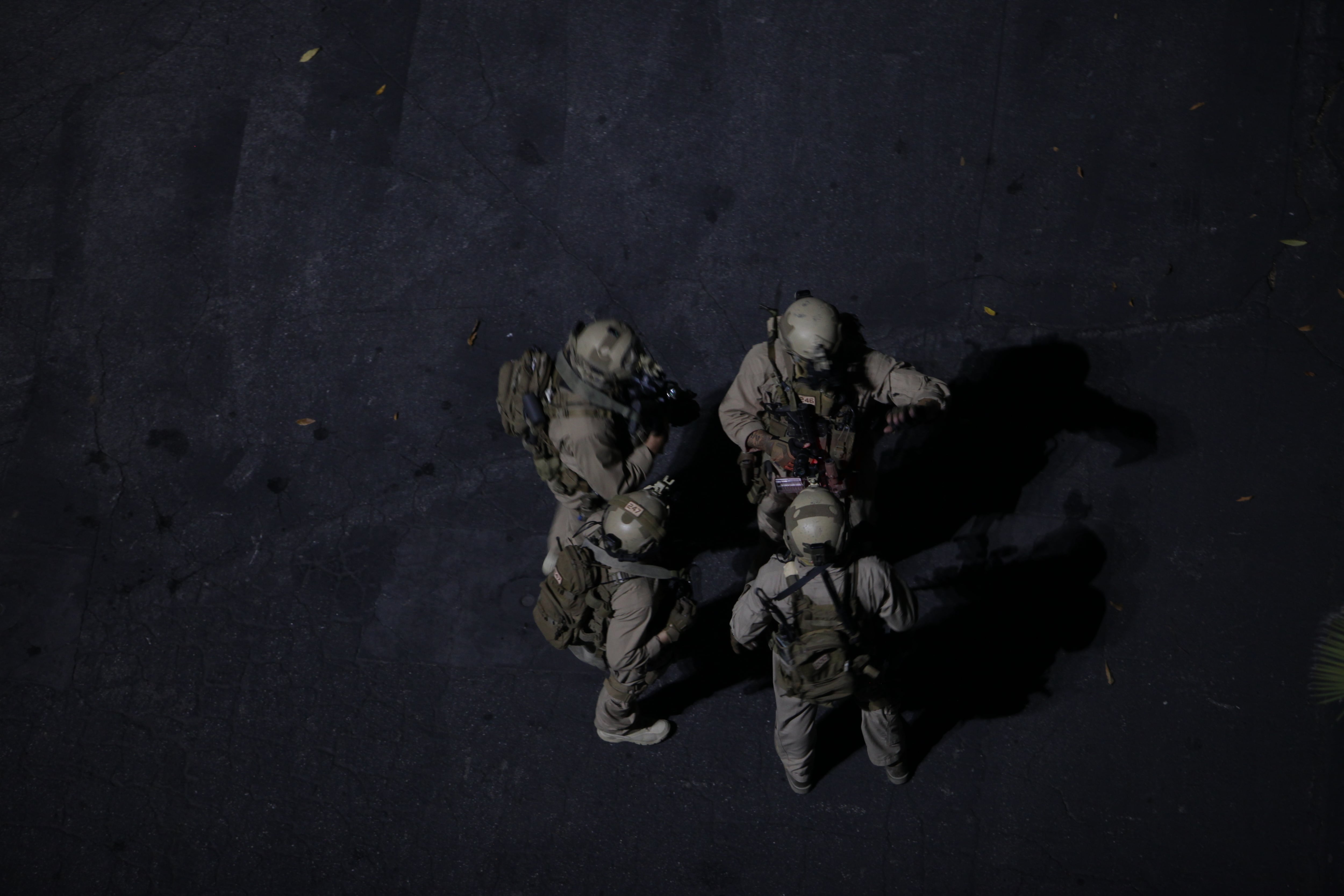Dodger Stadium became a training ground for Marines on Dec. 9 as they used the Major League ballpark for a mock raid involving an arms dealer.
It was a unique part of the 15th Marine Expeditionary Unit's training in preparation for a spring deployment. The MEU started urban combat training exercises on Dec. 5 at locales including and scenarios have included parts of downtown Los Angeles, other locations in the metropolitan area, and other parts of Southern California, Nevada and Arizona.
The mock -raid at the third-oldest Major League Baseball stadium, however, was the first training scenario with a high-profile landmark.
"It was overwhelming to know that we were going into a large structure," said Sgt. Guy Higgins, a reconnaissance man with the MEU's Force Recon Ddetachment. "We're going into key spaces that most civilians don't go into to destroy the enemy. It's a wild and humbling experience."
In the fictional training scenario, their Marines' target was a bad guy who sells copper plates for sophisticated improvised explosive devices, and ships them out of a soda truck. He used a job as a manager in the stadium's maintenance department as a cover.
"It was intricate," said Master Sgt. Randy Messineo, the operations chief for the detachment. "One would hope for that level of detail should we be called on to do this."

U.S. Marines with the 15th Marine Expeditionary Unit's Maritime Raid Force discuss the next stage in a raid at Dodger Stadium during realistic urban training in Los Angeles Dec. 8, 2014. RUT prepares the 15th MEU Marines for their upcoming deployment, enhancing their combat skills in environments similar to those they may find in future missions.
Photo Credit: Staff Sgt. Miguel Carrasco/Marine Corps
Aboutround 70 Marines flew 170 miles from Fort Hunter Liggett to Los Angeles in four MV-22B Ospreys from Marine Medium Tiltrotor Squadron 161 (Reinforced). The tiltrotors were accompanied by UH-1Y Venom and AH-1Z Viper helicopters and the aircraft landed at around 6 p.m. in a parking lot outside the stadium's third base line. A CH-53 also flew in to refuel the Venoms and Vipers after they landed.
The aircraft landed in a dark corner of the stadium's parking lot, and after getting out of the Ospreys the raid team established formations to begin to make their way into the stadium.
It's not as simple as just going into any door in the building. A stadium is a massive structure with scores of entry points, corridors and rooms. They had to make sure they went to the right place, said Sgt Eric Maehler, a reconnaissance man and team leader for the MEU's Maritime Raid Force.
From the parking lot they entered the 56,000-seat stadium, the largest in Major League Baseball.
"We made entry through the main gate," Higgins said.
His team went into the stadium's northwest side, near the bullpen. From there, they went through passageways and into the heart of the building.
The teams worked to find their target.
"It was a 360-degree dilemma that the raid force was faced with," Messineo said.
Eventually, they found their bad guy in the Dodgers' dugout. They captured him and made their way back out of the stadium to their aircraft for the ride homeand ride home.
It was more realistic than most training exercises, Maehler said. Rather than participating in another routine drill in a mock village made out of plywood on a base, he said, they were operating in a massive city as real people worked, played, and spent time with family. It was a different environment that can't be replicated.
"It provided a really different experience that's difficult to recreate in another atmosphere," he said. "The humanity of the city, the life, the noises, being able to process that and stay on task."

U.S. Marines with the 15th Marine Expeditionary Unit's Maritime Raid Force approach a breaching point at Dodger Stadium during realistic urban training in Los Angeles Dec. 8, 2014. RUT prepares the 15th MEU Marines for their upcoming deployment, enhancing their combat skills in environments similar to those they may find in future missions. (U.S. Marine Corps photo by Staff Sgt. Miguel Carrasco/Released)
Photo Credit: Staff Sgt. Miguel Carrasco, 15th Marine Expeditionary Unit
Baseball stadiums are unique buildings, but gTra Training in a baseball stadium can helps Marines prepare for raids on other large structures, participants said. Lessons learned at a ballpark can transfer to other large building designed for a lot of people, Messineo said.
"A part of being prepared for that is training for that standard. And being able to practice in a place like Dodger Stadium gives you that capability and confidence," he said.
The novelty uniqueness of operating in a high-profile landmark also created excitement about the exercise. Everyone, from the working party that organized the drill, to the Los Angeles public safety officials, Dodgers employees, and the raid force itself, all seemed thrilled about it, Messineo said.
"Really, this target captured the enthusiasm of all ranks, civilian and military. This was the most interesting and dynamic and fascinating objective that I've seen," he said.
He said it was such a valuable experience that he thinks it should be replicated throughout the Corps.
"World class target, world class execution," he said.
The MEU's realistic urban combat training in the LA area started on Dec.5 and runs until Dec. 19. Capt. Brian block, a spokesman for the MEU, said the unit is they are preparing for a spring deployment on the amphibious assault ships Essex, Anchorage and Rushmore. Marines will start training with the vessels in January or February.




